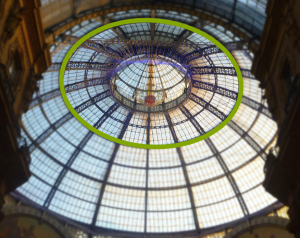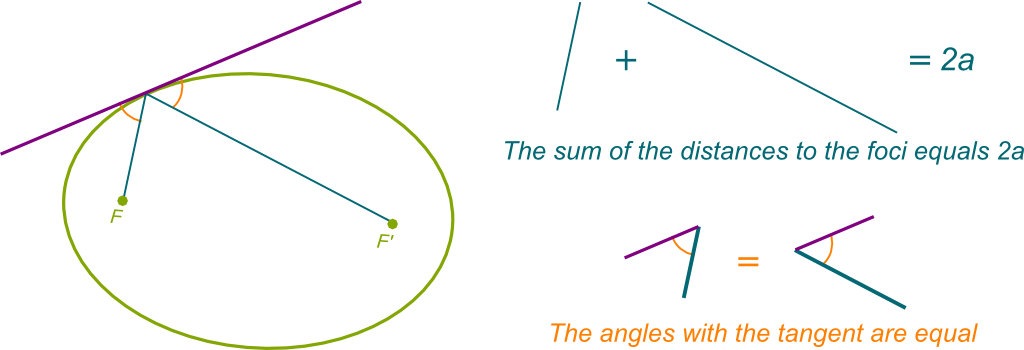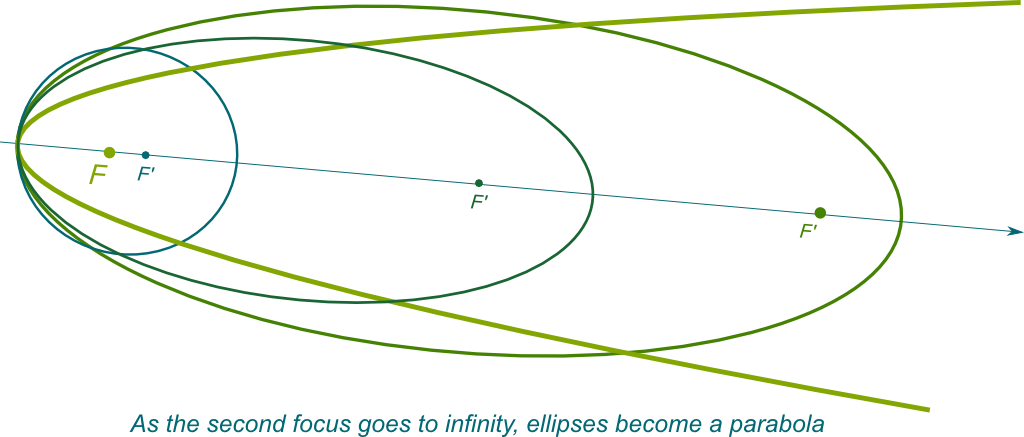Conics formed the chapter I hated the most in my undergrads. But that’s because exercices involve plenty of horrible algebraic computations. In this article, I’m proposing to just gaze at their beauty, their amazing mathematical properties and their uncountable applications!
Sure! For one thing, check how conics can be defined. They are intersections of a cone with a plane. Depending on how the plane is located with regards to the cone, you either obtain an ellipse, a parabola and hyperbola! How sweet is that?
But the simplicity of their geometry isn’t the only reason why these shapes are beautiful. What’s extraordinary is how they emerge and play a key role in so many fields!
Ellipses, Orbits and Galleria Vittorio Emanuele
Let’s start with ellipses. It took millenia to figure it out, but the motions of the cosmos aren’t made of perfect circles as it was long thought. Rather, as asserted by Johannes Kepler’s laws, the trajectories of objects of the universe are ruled by the geometry of ellipses!
This was a troubling mysteries for a century! Until came the brilliant Isaac Newton.
Newton proved that a few basic laws of mechanics could explain the elliptical motions of planets! And since these laws also matched Galileo’s laws of motions (including the parabolic curve of free falling objects we’ll get to later), Newton postulated that they were universal laws of Nature! 18 months later, he published the most important book of the History of physics, the Principia Mathematica. This book was to transform our whole understanding of the Universe, since, for the first time in History, there was a claim of a universal law! Something that was true at all levels, everywhere and always. This is illustrated in this extract from another of NOVA’s awesome science documentaries.
Yes! Unfortunately though, the only proof I know is the one involving differential calculus, which is both long and not insightful… Let’s rather talk more about the beauty of the shape of an ellipse!
Hehe… That’s a good point! A more natural perspective on ellipses is to define them as flattened circles. More precisely, an ellipse is obtained by applying a homothety according to an axis, as done below:
Such homothety is described in my article on symmetries, and plays a key role in Einstein’s special relativity. I like this definition as it explains why a circle in perspective is seen as an ellipse.
Yes! When we see in perspective, some axes of the circle are more inclined than others. From our perspective, the distances along these axes thus get more shrunk. Thus, what we see is a flattened circle, the flattening being unequal in different axes. That’s why we perceive circles as ellipses! This is the case, for instance, of the circles of the glass ceiling of the galleria Vittorio Emanuele in Milan you can see on the right. Pretty cool, right?
Another advantage of defining ellipses as flattened circles is that it’s then easy to generalize it to higher dimension ellipsoids! These are then defined as flattenings of $n$-spheres! Check my article on Poincaré conjecture to find out what a 3-sphere looks like!
Sorry, I just got carried away! Let’s look at the symmetry properties of ellipses.
Exactly! These axes are known as the minor and major axes. Let’s redraw the ellipse of the galleria to make these axes appear.
The semi-major and semi-minor axes are then defined as the largest and smallest distances between the center and the points of the ellipses. The center is commonly denoted $O$, while the semi-major and semi-minor axes are usually written $a$ and $b$.
Exactly! Or, you can also stretch distances along the minor axis! By the way, there’s a last symmetry you forgot…
Precisely! Now we have them all! In fact, the group of symmetries of the ellipse is the same as the group of symmetries of the Japanese Bridge of Hoi An in Vietnam I discussed in my article on symmetries.
No! No, no, no! That’s a recurrent misconception! The Sun is not the center of the ellipse described by the Earth! But it does have a particular position, as it’s located at a focus of the ellipse.
An ellipse has 2 foci. They are the points of the major axis which are at distance $a$ from the intersection between the minor axis and the ellipse. This corresponds to the following figure:
The distance between the foci and the center is then called the linear eccentricity $f$. Using Pythagorean theorem, it’s easy to see that $f$ is related to radii $a$ and $b$ by $f^2=a^2-b^2$. But let’s not dwell too much on the algebraic properties of the ellipse!
Place two pins located at the foci. Then, with a loop of length $2a+2f$, you can draw a perfect ellipse, as done below in a video by Mezon Videos!
Yes! That’s because, for any point of the ellipse, the two distances from this point to the foci add up to $2a$!
The magic of calculus enables to then deduce immediately that the angles in orange in the figure above are equal. This property has a pretty awesome consequence: If you play snooker on an elliptic pool table and if you place the white ball on a focus and the black one on the other focus, then, no matter how you hit the white ball (as long as you hit hard enough and don’t give it a weird spinning), you’ll be hitting the black ball with the white ball! Awesome, right?
Even better, combining the two properties, you can prove that a signal sent from of focus is received altogether at the other focus all at once! This is what’s displayed in the following video with waves:
An important feature of the ellipse is then described by the ratio $e=f/a$ called the eccentricity. As you can imagine, if $e$ is close to zero, then $f$ is very small compared to $a$, which means that the foci are nearly located at the center of the ellipse. The ellipse then looks nearly like a circle. On the opposite, if $e$ is nearly 1, then $f$ is nearly $a$, which means that the foci are nearly at the extremity of the major axis. This makes the ellipse very flat. In short, the more eccentric the ellipse is, the less it looks like the perfect circle!
Let’s wrap up this section with one last cool fact about ellipses! Another even more exact way of drawing ellipses is known as the trammel of Archimedes (even though we don’t know if Archimedes even knew about it!). It consists in fixing a rod to two shuttles moving along perpendicular rails, and to add a pen at the extremity of the rod. By sliding the shuttles, the pen then magically draws a beautiful ellipse! This is done is the following video of pocket83:
I know! And I’m sorry I’m not providing any proof in this article. Most of these properties are hard to prove without the power of algebra and calculus. I guess this is why the Greek mathematicians didn’t want to involve ellipses in their models of the universe.
Parabolas, Gravity and Archimedes Death Ray Mirror
Let’s move on to parabolas. Historically, parabolas have played a key role in the understanding of physics even before ellipses. Indeed, a century before Newton’s masterpiece, Galileo discovered that free falling objects all describe parabolic trajectories. Similarly, Marcus du Sautoy applies this principle in the following extract from BBC’s documentary The Code:
At Galileo’s time, understanding the mathematics of free falling objects was essential for designing military weapons, as it enabled to accurately predict the trajectories of canon balls!
The best way to visualize the trajectories of free falling objects is to look at water fountains. Let’s consider for instance the fountain on the right, with the mighty Eiffel tower in the back!
Thanks. Now, try to keep your eyes away from the Eiffel tower to stare at the water spray. The water drops describe parabolic trajectories!
That’s because of these annoying air frictions! Still, you can see that, at least until air frictions don’t become too important, the trajectories match those of the parabolas. And if you don’t believe that trajectories of free falling objects are those of parabolas, check wikipedia’s picture of a nice parabola-looking fountain!
Humm… Once again, the only explanation I have involves the power of calculus. But I’m not going to dwell on this. One thing you should know is that, in the right coordinate system, the coordinates of the points of the parabola are given by the equation $y=x^2$. All other parabolas are obtained by homothety and classical symmetries of this parabola, just like ellipses are obtained by deformation of the circle. This means that by stretching and rotating a parabola along axes, you can make any parabola! In fact, if you play Angry Birds, you probably have a good sense of all possible downwards parabolas!
Now, there’s a pretty awesome corollary to that. If you’re in a plane which follows the curve of a parabola, then you’ll feel as if the force of gravity has changed! In particular, if the plane takes the parabolic trajectory of a free-falling object, you’ll be feeling weightless in the plane! Isn’t it amazing!
It’s actually the exact same phenomenon that makes astronauts weightless! Check Derek Muller’s awesome explanation on Veritasium:
And what trajectory are astronauts following? (Hint: They’re in free fall!)
Yes there is! A parabola is actually an ellipse for which one of the focus has gone to infinity!
Exactly! Now, in fact, you could notice that $f$ becomes nearly equal to $a$. At the limit, we actually have $e=f/a=1$! This means that a parabola is sort of an ellipse of eccentricity 1. In other words, a parabola is an infinitely flattened ellipse. That’s why trajectories of free falling objects on Earth look like parabolas to us: They are ellipses which are so flattened that they are indistinguishable from parabolas!
You are being very perspicacious! Indeed, as we increase the inclination of an ellipse, we obtain more and more flattened ellipses, until, suddenly, we obtain a parabola! This is described below.
Hehe… That’s a great question, but way beyond the scope of this article. You’d need to dig into the awesomeness of topology to answer that!
Those which still make sense do! In particular, this is the case of the equal angle property!
As the other focus goes to infinity, lines which come from it and hit the part of the ellipse near the first focus get less and less inclined. In fact, it’s relevant and common to consider that lines coming from a point at infinity are all parallel.
Yes! More precisely, lines which are parallel to the axis of symmetry get reflected by the parabola towards the focus. This corresponds to the figure below:
Now, take this parabola, and make it a solid of revolution by rotating it along the axis of symmetry. You then obtain what’s known as a circular paraboloid. A great way to get one is to have a fluid rotating in a cup, like in this video by Arvind Gupta’s awesome Toys from Trash initiative.
Circular paraboloids have the properties that all intersections with a plane which contains the axis of symmetry are parabolas with the same focus. The consequence of that is that, when a message is sent from far away, since received signals are parallel, we can capture it very well by using a circular parabolic mirror and placing the receptor at the focus! This is why antennas in telecommunications are parabolic!
But this idea isn’t new. In fact, it was invented and exploited by Isaac Newton (yes, him again!), who designed a telescope to better observe the motions of the stars and come up with his laws of mechanics!
Well, actually, he wasn’t the first one to think of using parabolic mirrors! 2,000 years before him, the genius Archimedes from Syracuse used the same idea to defend his land from the Roman invaders: He used these mirrors to focus the parallel burning sunlights on a single point of an enemy ship to burn it down! The following extract is a video I took from the Musei Capitolini in Roma, in a temporary exposition on the Greek scholar:
I know! Unfortunately, this wasn’t enough for Syracuse to resist to the emerging Roman empire. This enabled Rome to discover Archimedes’ uncountable inventions, which I believe to be a key step towards its domination of the Mediterranean sea! In fact, it seems to me that Archimedes has then been at the top of human knowledge for the next 2,000 years, until Galileo finally rediscovered some of his brilliant achievements!
Well, the Muslims are actually the ones who first rediscovered Archimedes’ work, which have probably helped them be the most developed civilization at their apogee… But enough of History, let’s get back to maths!
Hyperbolas, Funnels and Non-Euclidean Geometry
Back when I was taking the oral entrance exam of the prestigious École Normale Supérieure in Paris (where 10 out of the 52 fields medal winners have been to!), I was given the following exercise:
Two stars orbit around each other. One explodes. What happens?
I did! It took me a whole hour, but I did! At least, I did much better than for my TIPE oral exam. Alas, I didn’t get in…
I found it, why can’t you?
Fine! In a certain coordinate system, the two stars will either have elliptic trajectories, or, if the amount of matter lost in the explosion is great, they will follow hyperbolic curves! This isn’t that surprising, given that trajectories of planets and comets orbiting near a star are in fact either elliptic or hyperbolic!
They are! It’s a bit as if, once the focus goes to infinity, it came back from it, but in the other sense, and as an anti-focus!
As the focus comes back in the other way, it’s as if it was given a negative sign. Indeed, the points of the hyperbola are now such that the difference of the distances to the foci is a constant, as displayed below. Note that this difference is the opposite depending on which arm of the hyperbola we consider.
One last important feature of hyperbolas is known as its asymptotes. If you’ve read my article on differential calculus, you know that derivatives are about zooming in. Well, asymptotes are pretty much the opposite. Namely, they unveil what happens as we zoom out:
As we zoom out, eventually, the hyperbola looks like two lines. These two lines are the asymptotes of the hyperbola. Now, a particularly interesting kind of hyperbolas is the kind whose asymptotes are horizontal and vertical, like the blue one and the green one on the right.
Hehe… Rotate it along the vertical axis. Then you get two solids of revolution, one on the top, the other on the bottom. Remove the one on the top. What you are left with is called a hyperbolic funnel. This funnel describes exactly the gravitational potential energy around the Sun, accordingly to Newton’s laws of gravity!
It means that, if you launch balls rolling on this funnel, you’d get the exact same trajectories as those Newton had predicted for planets (if, once again, there were none of these annoying frictions!).
But the reason why hyperbolas are the coolest of all conics is because of their applications to non-Euclidean geometry! This geometry is essential in descriptions of spacetime in special relativity, but also and mainly in general relativity. Amusingly, while Newton used ellipses to create his laws, Einstein used hyperbolas to top Newton! But applications aren’t restricted to the physics of gravity, as non-Euclidean geometry also has greatly increased our understanding of surfaces and spaces in general!
Mainly because of the potato chip!
Yes! Especially the Pringles ones, like the one on the right! Mathematically, they are known as the hyperbolic paraboloids. Its name comes from the fact that intersections with vertical planes yield parabolas, while intersections with horizontal planes produce hyperbolas! In differential calculus, the potato chip is the local description of a saddle point, which corresponds to a mountain pass in topography.
For a long, long, long time, the only geometry known was the Euclidean geometry, which is stuck in a sheet of paper, mathematically known as a plane. But then, as maps were drawn, people became aware of the importance of non-Euclidean geometry. Still, this geometry was often confined to geometry on spheres. Until the potato chip was found!
One weird aspect of potato chips is that the sum of the angles of a triangle add up to less than 180°… And this has all kinds of quirky consequences, like the existence of an infinite number of parallel lines which go through a point! And this has extremely useful applications to geometry and physics! For instance, because of this peculiarity, a flat sheet of paper cannot be bent into a potato chip. Otherwise, a triangle on the sheet of paper would still have angles which add up to 180° on the bent sheet. Amusingly this simple fact explains why we eat slices of pizza the way we do!
Yes! Check out this awesome TedEd video by Colm Kelleher!
These remarks gave rise to the extraordinary field of hyperbolic geometry! If you can, please write about hyperbolic geometry!
Let’s Conclude
I hope I’ve convinced you of the beauty of ellipses, parabolas and hyperbolas. Not only, they are rather easy to define, using conic intersections or else, but also, and more importantly, they are everywhere! And to truly appreciate them, I somehow think it’s better to avoid the classical analytical approach… To end this article, here’s one last link, with great animations, which enhances the importance of these conics!
























I’m impressed, I must say. Rarely do I encounter a blog that’s both equally educative and amusing, and let me tell you, you have hit the nail on the head. The problem is an issue that not enough men and women are speaking intelligently about. I am very happy I came across this in my search for something regarding this.|
What i do not realize is if truth be told how you’re not really a lot more smartly-liked than you may be right now. You are very intelligent. You realize therefore significantly relating to this topic, made me in my view believe it from a lot of numerous angles. Its like men and women aren’t interested except it is one thing to do with Lady gaga! Your personal stuffs outstanding. At all times maintain it up!
This site was… how do you say it? Relevant!! Finally I have found something that helped me.
Kudos!
I’ll right away grab your rss feed as I can not in finding your e-mail subscription link or newsletter service.
Do you’ve any? Please allow me understand so that I may just subscribe.
Thanks.